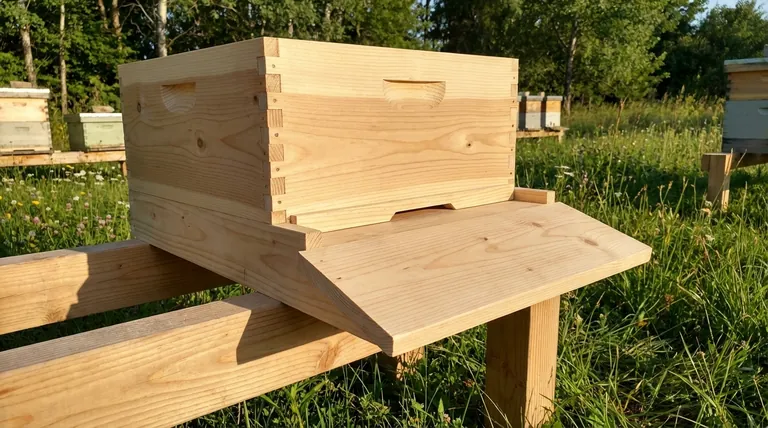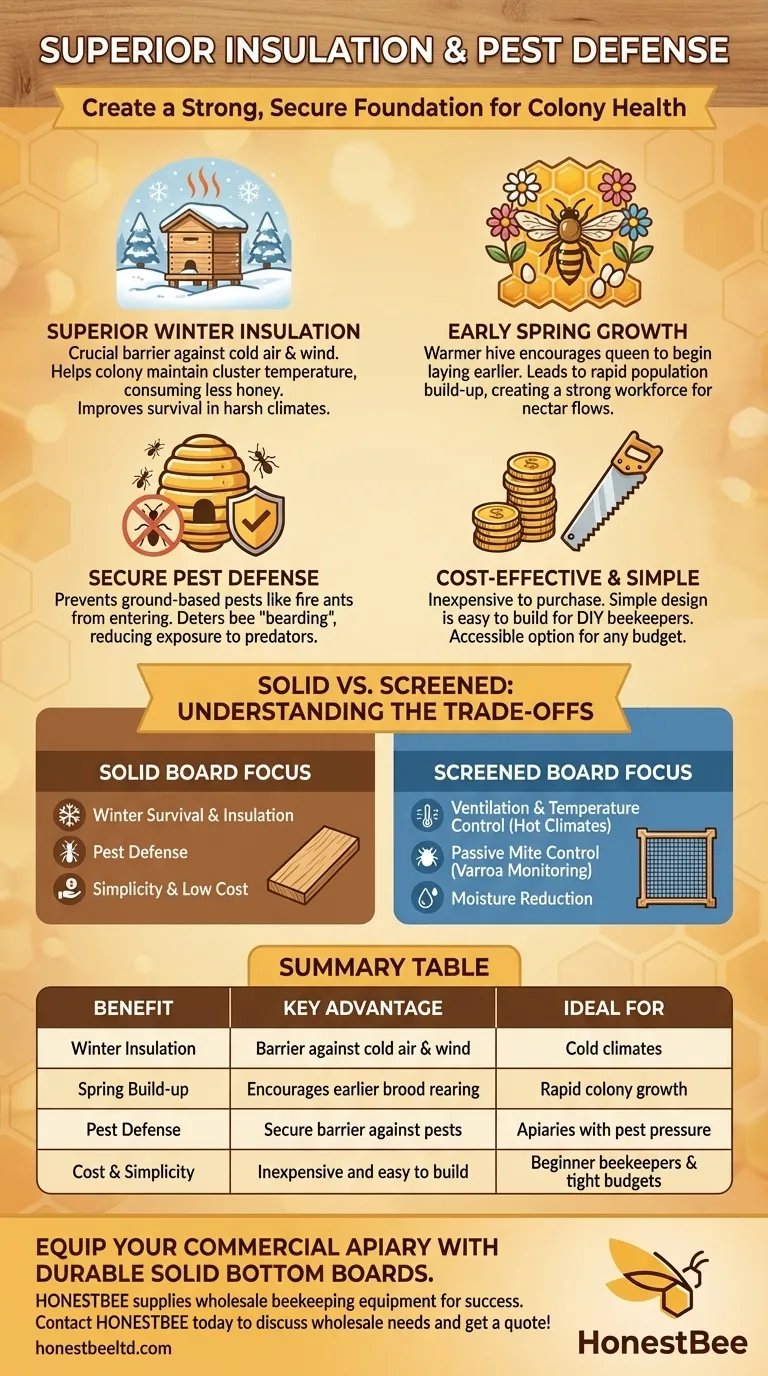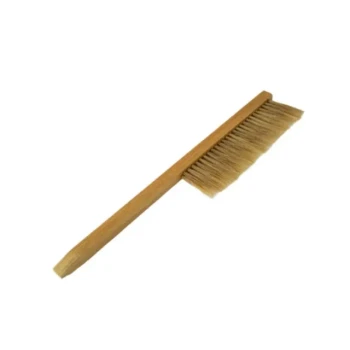The primary benefits of a solid bottom board are superior insulation during winter, the ability to encourage earlier brood rearing in the spring, and a more secure barrier against ground-based pests. They are also simple in design, making them cheap and easy to build for beekeepers of any experience level.
The choice between a solid and a screened bottom board is a fundamental decision in beekeeping. It represents a trade-off between the superior insulation and pest defense of a solid board versus the enhanced ventilation and passive mite control offered by a screened board.

The Core Advantages of a Solid Foundation
A solid bottom board is the traditional, classic base for a Langstroth hive. Its benefits stem from its simple, enclosed design, which creates a more controlled internal environment for the colony.
Superior Insulation for Colder Climates
A solid floor provides a crucial barrier against cold air and wind during the winter months. This insulation helps the colony maintain its cluster temperature more efficiently, consuming less honey and improving their chances of survival in harsh climates.
Encouraging Early Spring Growth
Because the hive stays warmer, the queen may be encouraged to begin laying eggs earlier in the spring. This can lead to a more rapid build-up of the colony's population, creating a stronger workforce ready for the first major nectar flows.
A More Secure Defense Against Pests
The solid floor prevents pests like fire ants or other intruders from entering the hive from below. It also deters bees from "bearding" or clumping on the underside of the hive, a behavior that can expose them to predators.
Simplicity and Cost-Effectiveness
There is no simpler design than a solid piece of wood. These bottom boards are inexpensive to purchase and straightforward for a DIY-minded beekeeper to construct, making them an accessible option for any budget.
Understanding the Trade-offs: Solid vs. Screened
Choosing a solid bottom board means forgoing the specific advantages of a screened bottom board. Understanding this contrast is key to making an informed decision for your specific needs.
Ventilation and Temperature Control
The most significant trade-off is ventilation. Screened bottom boards provide superior airflow, which helps reduce heat and moisture buildup inside the hive. This is particularly beneficial in hot, humid climates where it helps the bees regulate temperature more easily.
Varroa Mite Management
Screened bottoms offer a passive form of mite control. As Varroa mites fall off their host bees, a certain percentage will drop through the screen and out of the hive. This method also makes it simple to perform a "mite drop count" by placing a sticky board underneath to monitor infestation levels without disturbing the colony.
Hive Debris and Monitoring
With a solid board, all hive debris accumulates on the floor until the bees clean it out. While this can sometimes be a disadvantage, it also concentrates mites and debris, which can be useful for certain Varroa treatment methods that rely on vapors or contact.
Practical Considerations for Solid Boards
To get the most out of your equipment, proper preparation and maintenance are essential.
Maximizing Lifespan
Because they are made of wood and are close to the ground, solid bottom boards are susceptible to moisture and rot. It is highly recommended to prime and paint the board or treat the wood with a bee-safe preservative to maximize its lifespan.
Making the Right Choice for Your Apiary
Your local climate, management style, and pest pressures should guide your decision.
- If your primary focus is winter survival in a cold climate: A solid bottom board offers superior insulation that can be a critical advantage for your colony.
- If your primary focus is managing heat and humidity in a hot climate: A screened bottom board's ventilation is a powerful tool for hive health.
- If your primary focus is non-intrusive Varroa mite monitoring: A screened bottom board is the clear choice for performing easy and effective mite drop counts.
- If your primary focus is simplicity and the lowest possible cost: The solid bottom board is the most straightforward and budget-friendly option.
Ultimately, the best equipment is the one that helps you effectively manage your colonies in your unique environment.
Summary Table:
| Benefit | Key Advantage | Ideal For |
|---|---|---|
| Winter Insulation | Creates a barrier against cold air and wind, helping the colony survive harsh winters. | Beekeepers in cold climates. |
| Spring Build-up | Encourages earlier brood rearing, leading to a stronger workforce for nectar flows. | Beekeepers aiming for rapid colony growth. |
| Pest Defense | Provides a secure barrier against ground-based pests like fire ants. | Apiaries with significant pest pressure. |
| Cost & Simplicity | Inexpensive and easy to build or purchase, making it accessible for any budget. | Beginner beekeepers and those on a tight budget. |
Ready to equip your apiary with durable, high-performance bottom boards?
At HONESTBEE, we supply commercial apiaries and beekeeping equipment distributors with the wholesale supplies needed for success. Whether you're managing a few hives or a large-scale operation, our solid bottom boards provide the reliable foundation your colonies deserve.
Let us help you build a stronger, more resilient apiary. Contact HONESTBEE today to discuss your wholesale needs and get a quote!
Visual Guide

Related Products
- Langstroth Screen Bottom Board for Beekeeping Wholesale
- Australian Pine Wood Langstroth Screen Bottom Board for Wholesale
- HONESTBEE Wooden Bee Escape Board with Triangle Mesh Design for Beekeeping
- HONESTBEE Professional Frame Wiring Board and Jig
- Professional Galvanized Hive Strap with Secure Locking Buckle for Beekeeping
People Also Ask
- What are the assembly options for the Cypress Screened Bottom Board? Ready-to-Use for Immediate Hive Health
- What is the primary function of a screened bottom board in a hive? Enhance Ventilation & Control Varroa Mites
- What are the benefits of using a screened bottom board in warm or humid climates? Boost Hive Health & Control Pests
- How should the screened bottom board be used throughout the year? A Guide for Healthy Hives
- What are the benefits of using a screened bottom board for beehives? Improve Ventilation & Mite Control



















